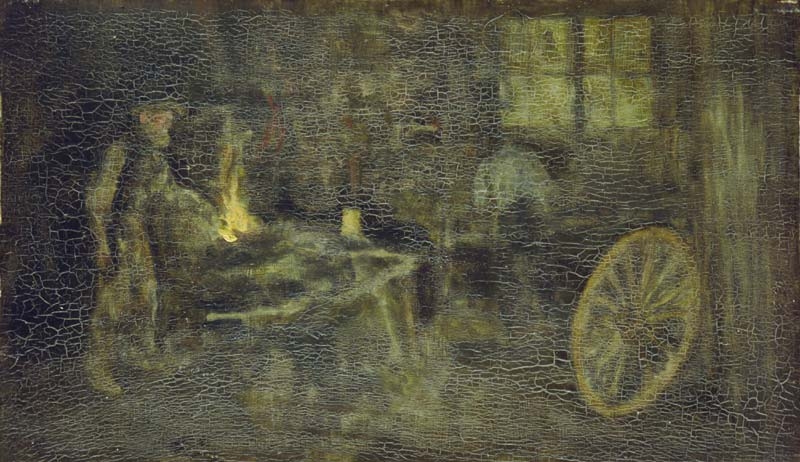Technique
Whistler was not satisfied with his early efforts at Lyme Regis and wrote to his wife Beatrice Philip (Mrs E. W. Godwin, Mrs J. McN. Whistler) (1857-1896):
'This work may & doubtless will bear witness to the innermost of the agonies we have gone through - Scars!- deep scars - you will perhaps find - but even they may not be without an attraction! - and in the work we may seem less boyish - but perhaps also less irresponsable! [sic]. Who knows!' 1
The scars may have been internal, arising from Whistler's concern about his mortally ill wife (she died in the following year), and the dire necessity of making money, as well as artistic concerns. However, it is also true that The Little Forge, Lyme Regis is now badly scarred, the image being obscured by extensive areas of fine craquelure.
The panel was primed with grey paint, and was thinly painted with a limited range of colours – rich browns and black shadows, with glints of yellow and red from the forge – and fine details on the workroom and the men at work that are almost invisible now. Dr Joyce H. Townsend explained the possible reason for Whistler's treatment of this panel:
'The crazed varnish is likely to be a temporary egg white one, recommended for use when paint was still wet, as a temporary varnish. When left behind, it grows highly insoluble, and with light exposure develops such crazing as it yellows. Whistler might have used it in the forge, the better to see his depiction of a dark subject in dark yet dazzling lighting conditions. He retouched on top of this varnish in three areas, most notably on the forge itself, but also the wheel rim and the smith’s apron – all key elements. Damage at the left edge indicates the panel was slid into a sketchbox while the paint was still wet. ...The metal ring for the wheel, on the forge itself, has been created by wiping away paint to reveal the priming, more or less. It was not done with a brush, as a continuous curve, but could have been done with a stump (a roll of paper used during etching).' 2
Conservation History
The panel has an auxiliary backing and framing device made from mahogany-type hardwood with adhered thin battens having mitred corners. 3 Stuck on the verso of this support panel is a label giving the title, and the address of Rosalind Birnie Philip (1873-1958). This suggests that this form of auxiliary backing was done after Whistler's death, for exhibition in the 1905 memorial exhibition.
The thinly painted panel is badly disfigured by extensive craquelure. This does not extend over the attached battens. A later layer of yellowed varnish extends over the panel and the battens as well.
Frame
38.1 x 48.1 x 7.2 cm. The label of the firm of Andre Chenue (fl. 1890s), packers and shipping agents in Paris, on the verso, probably dates from its exhibition in 1905.
Last updated: 22nd October 2020 by Margaret







